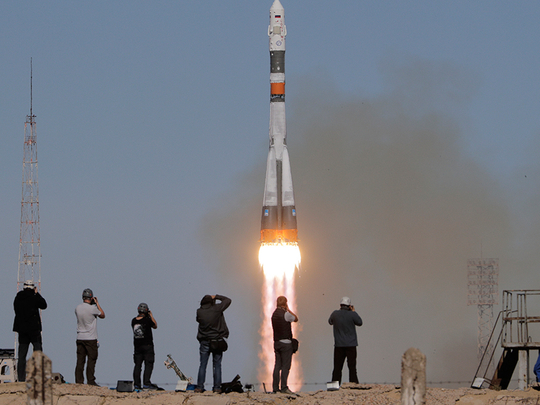
Moscow: A rocket carrying an American and a Russian astronaut failed minutes after lift-off Thursday morning, but the two crew members safely made an emergency return to Earth, the space agencies of both countries said.
The capsule had parachuted to Earth about 12 to 15 miles outside Zhezqazghan, a small city in central Kazakhstan, and neither of the crew members was injured, the Russian news agency Interfax reported.
An Antonov-12 transport plane was dispatched to drop a rescue team at the site, where helicopters were expected to pick up the astronauts, Interfax said.
Trouble was reported eight minutes after the Russian Soyuz rocket lift-off, when Nasa tweeted, “There’s been an issue with the booster from today’s launch.”
Eleven minutes later, it added, “The crew is returning to Earth in a ballistic descent mode,” meaning that it was falling without propulsion and that its direction was determined only by the craft’s momentum.
The agency added that ballistic descent means “a sharper angle of landing compared to normal,” potentially a threat to the crew’s safety. The angle of the capsule’s descent is carefully calibrated so that it does not overheat when plunging back through the Earth’s atmosphere.
Forty-two minutes after lift-off, Nasa tweeted that the Soyuz capsule had landed back on Earth. Four minutes later, it added, “search and rescue teams report they are in contact with the Soyuz crew, who report they are in good condition. The teams are en route to the landing site.”
A little more than an hour after launch, Dmitry Rogozin, chief of Roscosmos, the Russian space program, said on Twitter that the crew had been rescued. “A state commission has been established to investigate the causes” of the failure, he added.
Dmitry Peskov, the Kremlin spokesman, told journalists in Moscow: “Thank God the cosmonauts are alive. This is the main thing.”
Interfax reported that, according to a Russian space official, “the emergency occurred 119 seconds into the flight, during the separation of the side boosters of the first stage from the central booster of the second stage.” Then the second-stage booster rocket shut down.
The rocket lifted off at 4:40am. Eastern from Russia’s Baikonur Cosmodrome in Kazakhstan, about 240 miles southeast of Zhezqazghan, and it was supposed to ferry the astronauts Nick Hague and Alexey Ovchinin to the International Space Station.
Roscosmos, anticipating a successful launch, had already posted a glowing description of the flight on its Facebook page when disaster struck. Readers, thinking that the agency was trying to avoid mention of the incident, started to criticise it.
Soyuz rockets, in various versions, have been the mainstay of the Soviet and Russian space programs since the 1960s.
Since ending its space shuttle program in 2011, the United States has relied more heavily on other countries and private contractors to launch payloads and people into orbit.
Russian rockets ferrying goods aloft in recent years have had a checkered record. In December 2016, a Russian spacecraft carrying 2.6 tons of food, fuel and supplies — but no astronauts — to the International Space Station failed to reach orbit and largely burnt up in the atmosphere as it fell back down. In 2015, a Russian Progress cargo ship spun out of control, and was also destroyed as it fell back to Earth.
—New York Times News Service












